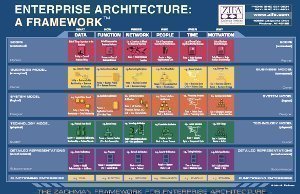What is the Zachman Framework?
The Zachman Framework gives a formal and structured method for defining and looking at an Enterprise Architecture framework. It is a 2D classification matrix that uses six basic communication questions – Who, What, When Where, Why, and How. These are expressed as six rows in the architecture depiction using a reification transformation. The framework is not considered a methodology, as it does not define the processes for collecting, managing, and using the data that it describes to gain potential insights on Enterprise relationships or operations. John Zachman first developed the concept in the 1980s while working at IBM. The framework was one of the first taxonomies to take into account the target audience as well as the issue(s) being addressed.
Zachman Framework Overview
Today, the Zachman framework refers to any of the frameworks that John Zachman has proposed since the 1980s. His initial framework was published in 1987 and was later updated in the 1990s where he extended and renamed the original work. Zachman International later provided a more developed framework that has become the industry standard for Enterprise architecture definitions and analysis. Overall, all versions of the framework were developed in order to organize and analyze data, and express enterprise architecture and a 2D dimensional schema used to organize a detailed representation of the enterprise being expressed.
Zachman Framework Concept
The Zachman framework is designed to be a logical and basic structure to organize and classify descriptive representations of a full enterprise. The order of the rows in the Zachman framework are significant in that they should align with the business concepts and the enterprise itself. The same complex item can be described in different ways in the framework depending on which category is being used. There are 36 total categories for describing anything within the Enterprise. The framework lets different people look at the same thing or process from different perspectives, which helps to create a more holistic view of the enterprise environment.
Zachman Framework Views
Each of the six rows in the Zachman framework provides a different view of a solution from a different perspective. The upper perspective (or row) is not considered to have a better understanding of the entire problem set or process than a lower row. However, each perspective must be able to provide enough detail to help define the solution for that particular perspective to be useful. These perspectives are also required to take into account others’ requirements as well as restraints that these requirements place on their own outcome. Lower row restraints will not necessarily affect the outcomes of the upper rows, however, depending on the overall structure of the Enterprise being expressed.
Overall, the Zachman framework is intended to be a holistic approach to managing information that can help eliminate the need to constantly integrate enterprise processes, procedures, and information.


Comments - No Responses to “What is the Zachman Framework?”
Sorry but comments are closed at this time.